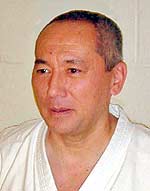Martial Mania
Shutô uke vs. shutô uchi
By George Donahue

The Japanese word “shutô” means “hand sword,”
but it’s called “knife hand” by most of the American
practitioners I know. I’m not sure whether this slightly different
rendering of the meaning adversely affects the understanding of the technique,
but I suspect it does.
Shutô is not actually the name of any technique. It’s merely
the basic hand formation used to execute either of two techniques and
their variations. Those techniques are shutô uchi and shutô
uke. The former is properly translated “hand-sword strike”
and it comprises strikes, thrusts, and other blows. The latter is properly
translated “hand-sword reception,” but instead of “reception”
we usually say “block.” When we say “block,” however,
we have to be careful not to forget that uke is more than blocking. It
comprises blocks, parries, traps, even grabs. It’s the much the
same term that is used for the receiving partner in two-person drills.
You might consider this mere quibbling, but I think that the lack of understanding
of this difference between uke and uchi has led to an unnecessary loss
of skill.
In the kata that I know, there are some movements that could be executed
as either shutô uchi or shutô uke, or sometimes both simultaneously.
There are other movements that are clearly meant to be shutô uchi,
and yet other movements that are clearly meant to be shutô uke.
The visible difference between the two is subtle, perhaps too subtle for
a beginner to differentiate, but it is serious.
The problem is that too many of us, at these points in kata, execute merely
a shutô, and neither uchi nor uke. That means that we are just posturing
and not really doing anything that useful. I think this is where the mistranslation
comes into play. If we believe we’re wielding a “knife hand”
then we may subconsciously assume that our hand takes on the aspects of
a real knife. That is, it’s got a sharp edge and a sharp point and
prudent people will be wary of it. We see this in movies and on television,
where the hero assumes a pose like a constipated giraffe, with great show
presents his awesome knife hands, and sends a ripple of fear up the spine
of his enemy. That’s acting, and poor acting at that.
If we merely hold out a real knife between ourselves and someone who is
trying to move in on us to harm us, when they meet the knife they will
be sliced or stabbed. Merely holding it out might be enough. Fortunately
(because we don’t need the curse of Edward Scissorhands), our hands
are neither sharp nor pointed. Merely holding them out doesn’t do
a whole lot of good. In fact, most often what we’re doing is offering
our attacker a handle to better control us.
So, instead of thinking that we’re executing a “knife hand”
whatever, we should concentrate in our training on executing a real technique.
When we analyze the opportunities for “shutô+ something”
in our kata, we should remember that we are using a figurative hand sword
to do something, that we don’t wield a real knife but a flesh and
bone weapon that has it’s own good points and “edges.”
Most of all, we have to do something, anything—other than pose dramatically—with
it. A poseur is a good target.
Copyright © 2008 George Donahue
& FightingArts.com. All rights reserved.
About The Author:
George Donahue has been on the board of FightingArts.com
since its inception. He is a freelance writer and editor, providing literary
and consulting services to writers, literary agents, and publishers, as
well to advertising agencies. He has worked in publishing for more than
three decades, beginning as a journal and legal editor. Among his positions
have been editorial stints at Random House; Tuttle Publishing, where he
was the executive editor, martial arts editor, and Asian Studies editor;
and Lyons Press, where he was the senior acquisitions editor and where
he established a martial arts publishing program. He is a 6th dan student
of karate and kobujutsu—as well as Yamane Ryu Bojutsu—of Shinzato
Katsuhiko in Okinawa Karatedo Shorin Ryu Kishaba Juku. He was also a student
of Kishaba Chokei and Nakamura Seigi until their deaths. He teaches Kishaba
Juku in New York and Connecticut, as well as traveling to provide seminars
and special training in karate, weapons, and self-defense. His early training
was in judo and jujutsu, primarily with Ando Shunnosuke in Tokyo. He also
studied kyujutsu (archery), sojutsu (spear), and kenjutsu (swordsmanship)
in Japan as a youth. Following his move to the US, he continued to practice
judo and jujutsu, as well as marksmanship with bow and gun, and began
the study of Matsubayashi Ryu karate in his late teens. Subsequently,
he has studied aikido and taiji and cross trained in ying jow pai kung
fu. |